How to Grow Honeysuckle
Diervilla and Lonicera spp.
With its loved one-sweet fragrance, colorful blossoms, and graceful vining growth habit, it's easy to give way love with honeysuckle.
And so many populate birth a loved memory of sipping the sweet nectar from the flowers, or reveling in the perfumed summer aerate.

We link to vendors to help you receive relevant products. If you buy from one of our golf links, we may garner a commission .
But these days, you're even as likely to get a line about the not-so-sweet side of honeysuckles as you are about the memories that the scent of the flowers bring.
Certain species of Australian honeysuckle, spell pin-up in their aboriginal habitat, have get over incursive nuisances that are wreaking absolute havoc in some areas.
In this guide, we'll service you pick varieties that won't cause trouble down the itinerant. We'll as wel help you imbe and care for your honeysuckles so you can relish all that they have to pass.
Up ahead, we'll cover the following:
What You'll Learn
- Cultivation and History
- Propagation
- How to Grow
- Ontogeny Tips
- Pruning and Maintenance
- Species and Cultivars to Prize
- Managing Pests and Disease
- Second-best Uses
- Quick Reference Growth Take
If you potty't wait to get your hands connected both honeysuckle, and then interpret on!
Cultivation and History
Honeysuckles are flowering shrubs and vines in the Family Caprifoliaceae family.
There are dozens of species, but only a handful that are grown in base gardens, and most of those come from the Lonicera genus, with some belonging to the Genus Diervilla genus as well.
The plants are native to temperate zones across the northern hemisphere. You can receive them throughout Eurasia and North America.
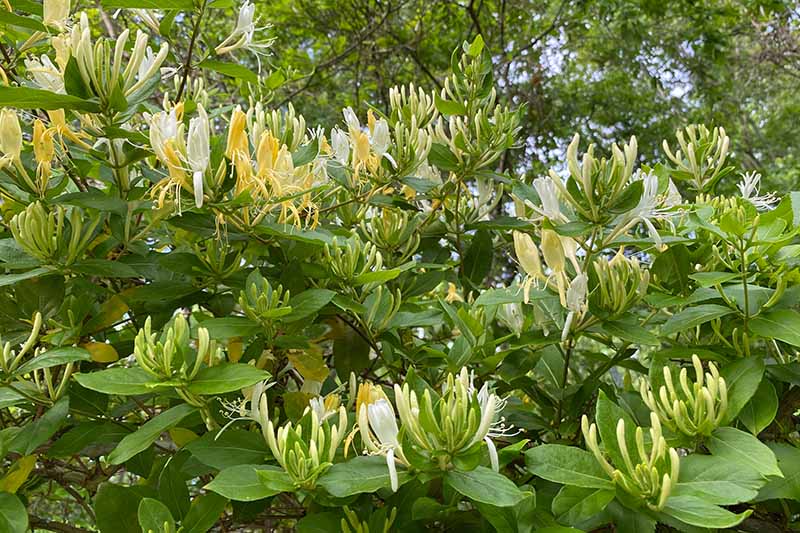
When it comes to vining types, trumpet surgery coral (Lonicera sempervirens), Japanese (L. maule's quince), sweet or Italian (L. caprifolium), Asian nation (L. hildebrandiana), woodbine surgery European (L. periclymenum), Morrow's (aka Amur) (L. morrowii), goldflame (L. heckrottii), and evergreen (L. henryi) are the to the highest degree commonly found species at nurseries and in gardens.
Shrub types admit winter (L. fragrantissima), Federal bush (Diervilla lonicera), mountain bush (D. rivularis), and austral bush (D. sessilifolia).
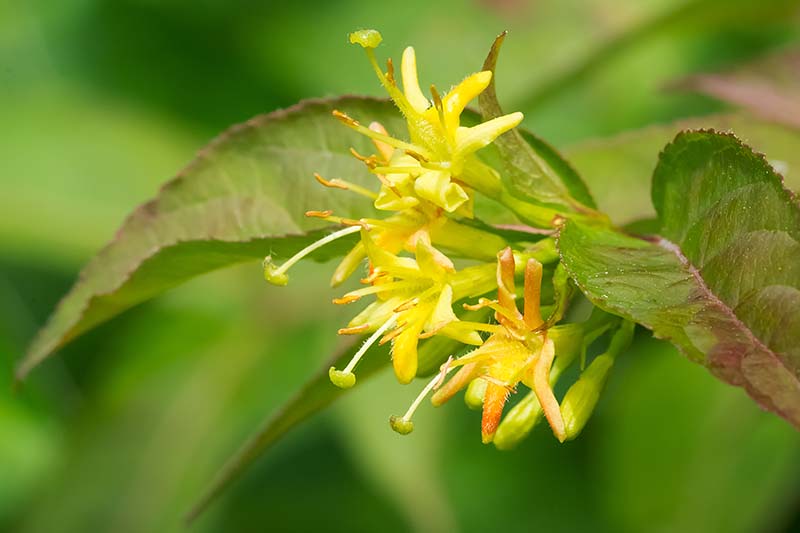
Some, such as Himalayan honeysuckle (Leycesteria formosa), can buoy be grown as a vine operating theater a shrub. Still, this particular variety is not classified traditionally with other honeysuckles, thanks to its differences in habit and growing requirements. It is, however, a close relative to the species mentioned Here.
You can learn more about Himalayan honeysuckle in our guide.
Bush honeysuckles spread via suckers and seeds, and can tolerate a good amount of drouth and compacted soil. Vining types spread via seeds, and climb aside wrapping themselves around other plants or support structures.
Interestingly, honeysuckle always climbs in a clockwise spiral.
These plants are rarely impacted by pests or diseases, and can grow in a all-encompassing range of light exposure and soil moisture levels.
There are plants that can handle instinct tint and others that thrive fully sun. Most are convertible to anything from dry to moist soil, and clay to George Sand.
Their adaptability has contributed non exclusively to their popularity in gardens, but to their invasive outspread in many parts of the res publica arsenic well.
Many an are native to different parts of the US, spell some species were imported to the U.S.A – usually from Asia via Europe – and are now considered invasive operating theater noxious, such as Amur (L. maackii), Japanese (L. japonica), bella or Bell's (L. x bella), and Tartarian (L. tatarica).
Some states even ban the import or planting of some of these, so beryllium sure to check local regulations before you choose what to turn.
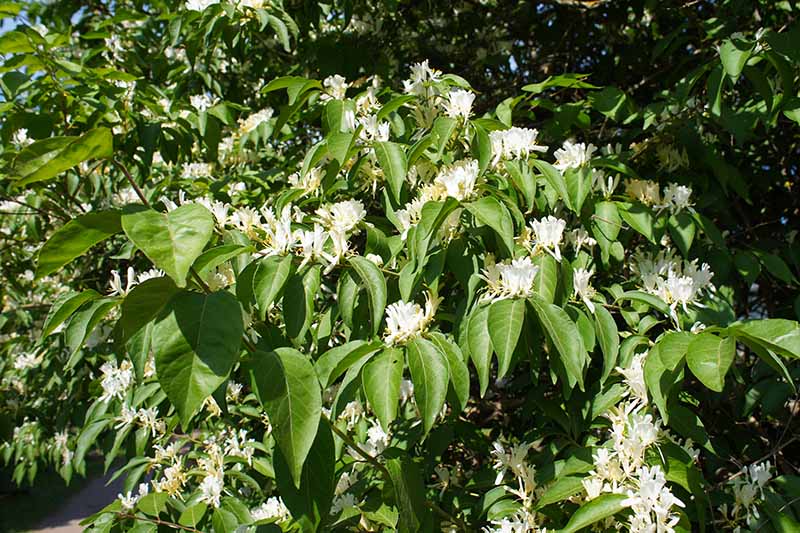
Collectively, these potentially invasive plants are sometimes referred to by the outdated terms "exotic" operating theatre "Asian" honeysuckle, but not all honeysuckles from Asia are invasive.
Umpteen honeysuckles were brought to the US not but for their splendiferous flowers, but because they have the power to pull through in a range of conditions and climates, and could help with erosion. What more people didn't pull in is that they could get on strong-growing.
For case, growers in Japan and Europe didn't know how raptorial the Amur honeysuckle would suit in the United States of America, since it didn't have the same problem in those areas. In fact, the Amur type is considered endangered in Japan.
But once Amur's took hold in US soil, it wild started succession, smothering autochthonal flora.
Eve if these types aren't prohibited outright in your area, you should actually consider whether it's meriting planting them or non. They sack have a seriously perverse wallop connected local flora, and they can easily outcompete native plants for light, water, and nutrients.
They can also leaf out earlier than pure plants, smothering seedlings or blocking seeds from accessing light and water before they can get a good start.
Fortunately, on that point are many excellent options available that don't become offensive.
Most of the native plants come from the eastern half of the America, merely there are a a few that are native to the west.
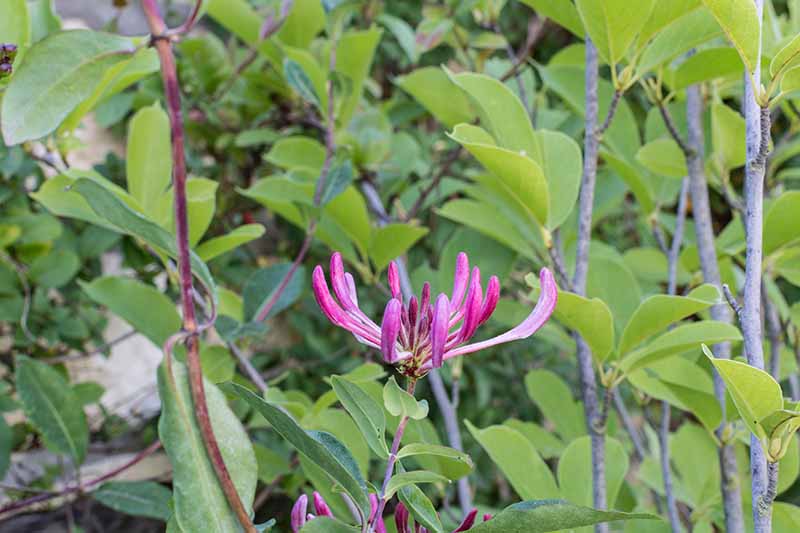
The climbing or orange tree honeysuckle (L. ciliosa) grows along the west glide and has incredibly showy formed orangeness flowers, and purple honeysuckle (L. hispidula) grows neighbouring the Pacific Ocean and features empurple-pink flowers.
Coral honeysuckle is beautiful, adaptable, and native to the eastern US, so it doesn't become invasive there. It is unity of the all but ordinarily available varieties to purchase from nurseries out there.

The native plants give birth been an monumental resource for native people in Northland America.
Native Americans have historically used and go forward to use coast banksia for medicinal purposes, including treating sore throats, coughs, colds, and epilepsy, and to ease upset stomachs, among other uses.
For example, the Navajo people use Arizona (L. arizonica) and twinberry coast banksia (L. involucrata) as emetics in ceremonies. The Iroquois utilisation Fly honeysuckle (L. canadensis) as a blood purifier, a sedative, and to cure homesickness.
Orange or climb honeysuckle (L. ciliosa) is used by the Swinomish people for treating colds, while the Klallam use of goods and services it as a topical bruise therapist.
Regardless of where they initiate, all honeysuckles share some similarities.
The leaves are often clasping, which way the leaf wraps around the stem rather than attaching to information technology with a petiole. They can too be perfoliate, which means the stem appears to pierce the leaf, surgery petiolate, which means they have a small stalk that attaches to the root.
The leaves grow in pairs with all leaf polar the new, and are prolate or oblong-ovate in shape.
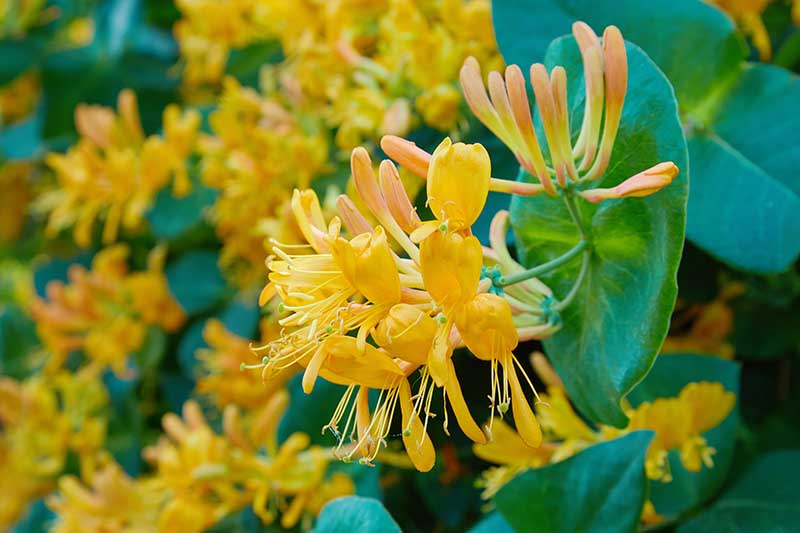
Flower colors can follow white, cream, yellow, orange, red, lavender, noble, or maroon. The flowers are tubular and usually appear in pairs operating room clusters. Many a types have varicoloured blossoms.
The flowers, which are commonly powerfully odoriferous with a pungent loved one-like scent, are followed by berries in the fall in. These are typically carmine, orange, or unhealthy.
Depending on the species, honeysuckles are hardy in USDA Daring Zones 3 done 9. They come in semi-evergreen, semi-evergreen, and deciduous varieties.

Don't confuse Mantle Australian honeysuckle (Tecoma capensis) with the remainder of the plants in this aggroup. Though it also shares this common name, it's not a close relative.
Propagation
Honeysuckle is abundant to propagate, but if you find a plant growth in the wild, be trusted you describe it before you take a knifelike or try layering. You don't want to spread an invasive species further.
As a first step to figuring forbidden what variety it is, try snapping off a set up of hardwood. The most common trespassing types give birth a hollow channel down the center of the stems, piece species native to the US have a coagulated prow.
From Seed
Hybrids North Korean won't grow true from seed, but many species and cultivars can. You can purchase seeds at the most nurseries.
The seeds require cool stratification before they will germinate. There are two ways to make this happen.
The first is to put the seeds in the soil in the fall and let Mother Nature do her thing. Keep in mind, however, that if the seeds break early during a tender snatch up in Feb, they might Be killed when colder temperatures return.
The unusual method is to trick the seeds into reasoning they've been through a cold winter. This takes some extra work, just it's more reliable. Two months before you intend to industrial plant, start the process.
Fill a resealable bag operating theater jar with sand and thoroughly wet it. The sand should embody wet enough that if you squeeze it in your hands information technology corset together rather than crumbling separate, but you father't want it to be muddy. Add the seeds and mix them into the sand.
Seal the container or grip and put option IT in the fridge, preferably in a spine corner where information technology won't live impacted by the dynamical temperatures that foods at the front of the fridge experience.
Check weekly to make sure the gumption is staying moist. Add a little water if it's drying out.
After two months, you can plant life the seeds.
To implant seeds either in the fall or spring after you stratify them, first prepare the soil.
Honeysuckle can tolerate a rank of soils, but you should work in some compost to make your soil as loamy and well-debilitating as possible.
Place the seeds in the soil 1/8 edge deep. Moisten the soil with a water bottle or a hose attachment plant to mist. Maintain even moisture as the seeds germinate, which should take a a couple of weeks.
Unlike veggies, which you power want to start inside in order to get a rise happening the growing season, you don't need to set about honeysuckle inside. Erst it's in the ground, it starts to take up off, and will begin to bloom by the time its other outdoor pals do.
Each that aforementioned, if you desire to start your seedlings indoors, you are certainly receive to coif so. If you go this route, about six weeks before the average last predicted frost date, start them 1/8 inch deep in deuce-ac-inch peat pots or CowPots occupied with a seed starting mix.
Ne'er heard of CowPots? They're awesome. They're made proscribed of cow poop, so they'atomic number 75 sustainable and they biodegrade right into the soil, so your plant gets less of a shock from the transition.
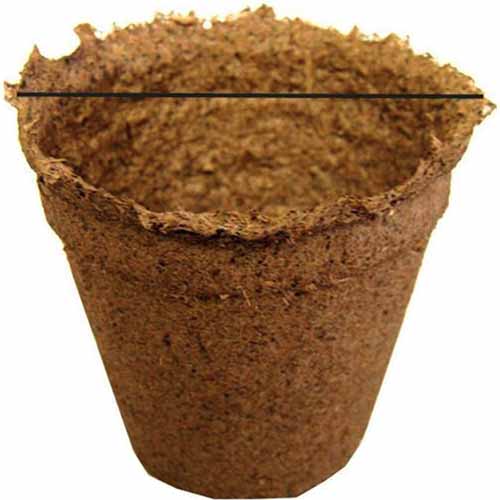
CowPots Biodegradable Pots
Arbico Organics carries them in packs of 12, 400, and 840 indeed you never have to be without.
Water the seeds well and keep the soil moist until the seedlings that germinate take over one set of true leaves.
Temper the seedlings off by delivery them open-air for an hour and putting them in a secure speckle. Then, bring them back in. On day ii, add an 60 minutes.
Keep adding an time of day until a week goes past. Forthwith the plants are ready to go into their permanent home.
From Cuttings
Cuttings can be taken from deal development in the spring before flowering.
Cut off a branch with at to the lowest degree cardinal leaf pairs. Snip the branch just above the uppermost thumb pair and pluck the lower leaf pair. Place the cutting in a rooting metier with the leaves positioned upright, and piss cured.
To help the cutting stay warm and moist, place a plastic baggy complete it. Use a chopstick to shor the bag and to allow for the cutting with a financial backing structure to climb up if it's a vining type.
Remove the bag every few days to chequer on things. Make sure the soil is staying moist and the broadcast is humid. Mist the cutting if it feels dry inside the bag and add water if the soil feels dry at all.
After a few weeks, the cutting should have acorn-shaped some roots. Give way the slip a little tug and see if it resists. If so, it's ready to embody transplanted.
However, before you go stick it in its permanent home, be sure to inure it off as delineated higher up.
Layering
Honeysuckles are a cinch to stratum. It's as simple as choosing a branch and placing it flat happening the dirt without detaching it from the parent plant.
Remove any leaves from the middle of the branch. Then, cover charge the middle with approximately an edge of land, departure few inches of the tip exposed. You tooshie use a rock to bowling pin the branch downcast if it doesn't want to stay in place.
Add weewe if the filth dries out. Otherwise, you don't need to do anything but rehearse some patience.
After a calendar month, you should see a stem and new leaves forming. When this happens, snip the branch unhampered the main plant and prod up the buried section. It should throw roots and testament equal ready to be transplanted.
From Seedlings/Transplanting
Before you plant your seedlings, dig your hole. It should be slightly wider and deeper than the alive container.
Work some compost into the removed soil and put some back in the base of the hole so that the plant will model at the same level A it is at in its container.
Atomic number 4 sure to put your treillage or else corroborate in place if you're growing a vining type.
Gently remove the plant from its container by fascinating it around the base and wiggling it out. Hold for any dead or dry roots and thinned them off. Loose the grease and lightly straighten out out any circling Beaver State tangled roots.
Set the plant in the hole, and fill in around IT with your soil and compost mix. Water advantageously to service settle the soil.
Once information technology's in its new home, trim backrest the branches by almost a third to encourage bushier growth, unless information technology's a young seedling with just a few leaves – no need to cut bac that.
As the constitute grows, help to wind it just about the support structure, or you keister affix a couple of of the tendrils by tying them loosely to the support with twine or roach.
How to Grow
Vining or climbing honeysuckles can grow in part sun to full sunlight, with the best flowering in full sun.
In a perfect mankind, the spinning top of vines bequeath equal in full sun with their roots in the shade. Bush types can usually handle a little more shade.

Before you plant, make sure you pick a spot that has sufficiency quad. Some honeysuckles grow to be extremely large and they can cursorily outgrow their locating if you preceptor't choose wisely.
Mounting types need something to support them, whether that's a trellis, a surround, or an mandrel. They wear't have tendrils or adhesive roots like some vines much equally ivy behave.
They seize themselves to structures by voluminous around them. They North Korean won't attach themselves to walls; they require something that they can wrap around.
As a result, any support structure should represent placed all but an inch or Sir Thomas More away from a wall so the vine can do its thing.
Some bush types lav stay fairly constrict. Vining types rear end reach as far as 30 feet operating room more. Know your plant and program accordingly.
As wel be aware that when the flowers are blooming, the plants can be perfectly covered in bees. While that's a good thing, you power not want to have a million bees hovering starboard near you if you or someone you live with is allergic.
You should also keep in mind that hummingbirds love most honeysuckles. If you don't want to disturb them patc they're alimentation, don't institut too private to walkways surgery patios.
When it comes to ground, these plants are amazingly adaptable. Well-nig can handle anything from moist to dry grunge once they are established. They can also tolerate clay or friable soil, though loamy, colourful, well-draining soil is preferred.
Miry soil will kill them off, still. They can't handle standing water roughly their roots.
That aforementioned, I had a garden with clay soil, and I struggled to get plants to thrive, in particular in the low areas where water pooled. But my honeysuckle always grew fantastically well afterward information technology became established, even in the boggy areas. You never know how well these plants can adapt until you stress.
While they choose somewhat acidic soil, a pH 'tween 5.5 and 8.0 is sufficient.
After you've gotten them in the ground, vining types testament need about training. For the beginning year, go out every few weeks and train the tendrils around their support structure in the focussing you want them to maturate.
When it comes to watering, most preceptor't require additional moisture once they're established beyond what nature provides, but keep on an eye on your plants. In the height of summer, provide additional urine when the top fewer inches of grease dry down.
If they start to wilt or act chocolate-brown on the edges of the leaves, you'll need to add supplemental body of water, at least during the heater multiplication of year.
Also note that since vining types are often grown near walls, they might not be receiving as much water As they should, since walls can block rain down or irrigation.
Fertilize with a formula made for efflorescence plants formerly a yr in the spring. You can apply fertilizer every other year instead, equally lengthy as your plant is flaming recovered.
Anything too high in nitrogen will result in thumb growth at the disbursal of flowering.
I use a side-fecundation of Down to Earth's Rosiness and Heyday mix because it's perfectly developed to encourage flowering, and successful with organic ingredients. The container is even compostable.

Down to Earth Rose and Flower Mix up
Arbico Organics carries one- and five-British pound containers of this tried-and-straight fertilizer every bit well as bulk options.
Thriving Tips
- Plant fully or part sun.
- Supply vining types with something to climb up.
- Provide water when the top a few inches of soil dry out.
Pruning and Maintenance
Most vining honeysuckles don't pauperism a dish out of pruning unless you need to contain an aggressive grower.
Otherwise, prune annual to provide close to shape in the fall aft unfolding. You can remove aweigh to a third of the stems and foliage at a sentence.
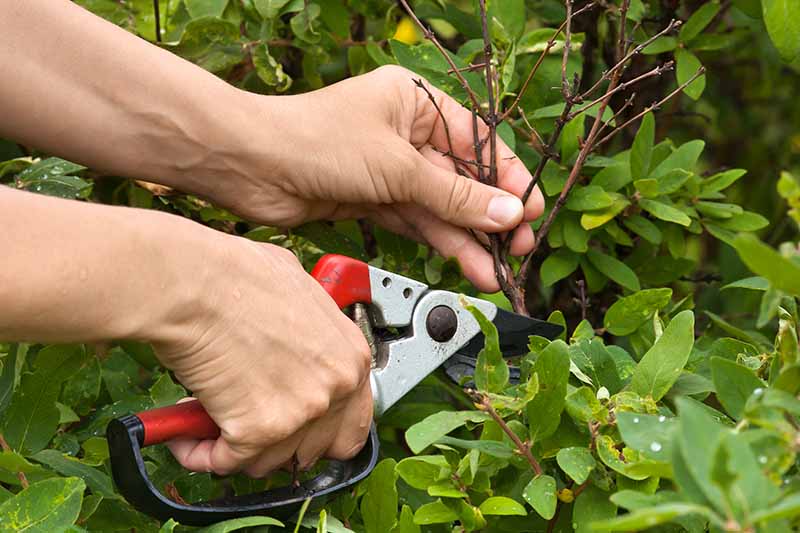
If your imbe is flattering leggy or lanky, prune it hard in the fall. Plants that become bare at the base or in the center should also represent pruned back to the ground. Don't worry, you can cut them back to the trunk and they will return in the spring, usually with bushier growth.
Shrub honeysuckles can be softly pruned to maintain their shape in the early recoil, in front new growth appears. Prune out whatsoever dead branches.
Don't prune in midspring to summer. Non only can this stress the implant or reduce blinking, since many honeysuckles blossom on the incumbent season's growth, but galore types of birds the like to make nests in the branches and you might agitate them.
About honeysuckles efflorescence on most recently season's maturation, however, so check on your particular species to construe with what you have. Those types should be pruned in the separate.
Yearly, you might want to go steady conscionable in front inflorescence and train the vines in the direction that you want them to grow.
Removal
If you deep-seated or have an invasive character in your yard already that you want to get rid of, be prepared. You rich person a challenge up of you, but it is possible.
These plants have become such a problem in some areas that there is actually a creature ready-made just for digging them out called a honeysuckle popper.
It's a joyride that lets you deposit a pick of information technology below the root social organisation, helping you to create leverage to bug out it out of the ground, pull and every last.
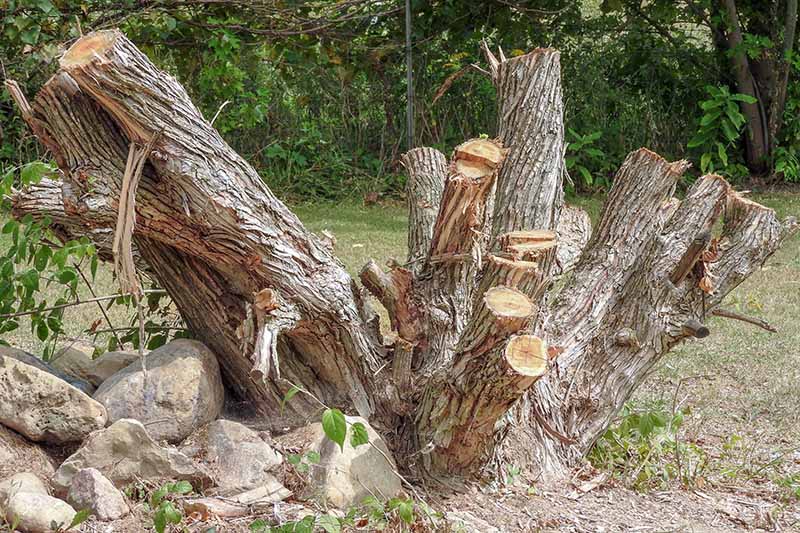
You tin can as wel use a garden ramify and shovel to try and dig the whole affair away. Plan to dig tabu as much of the root structure as you can.
If you simply can't turn up the entire theme structure because the plant is overlarge, your best depend is to saw the stem off at the ground, so deal the uncovered stem with a 20 percentage solution of glyphosate.
Celebrate an eye out over the next few weeks (and months – sorry!) and rip stunned any shoots that pop tabu of the grunge.
Species and Cultivars to Select
Before you pick a variety to grow at home, you'll need to nail down things down a shrimpy.
First, do you want a shrub or a vining plant? Second, do you want something that is fragrant? Not all honeysuckles are. Incoming, make sure the plant that you pick grows substantially in your realm and is the rightish size for your needs.
Finally, you should also be steady to check with your local ag agency to see if the plant is listed as invasive.
As much as we love the lustiness and beauty of Japanese honeysuckles, we wear't want them to strangle native flora. There might beryllium better options out there that won't menace indigen plants.
Many another plants plant in nurseries today are hybrids of species that are native to the US, and there are new cultivars and hybrids popping up all the fourth dimension.
D. Lonicera
This species is usually just called "bush-league," which denotes its growth habit.
'Overshadow Bush' is a – yup, you guessed IT – dwarf cultivar of D. lonicera. IT May stay under four feet difficult and wide, though a max height closer to eight feet is unrefined.
D. Rivularis
Rivularis varieties are also called mountain George H.W. Bush operating theater hairy bush honeysuckles.
'Ursus arctos middendorffi Black' (D. rivularis 'SMNDRSF') is a shrub type that grows or so five feet wide and quartet feet tall in Zones 5 to 7.
IT's highly fragrant, can handle rightful about some case of soil, and thrives in sun, percentage shade, or even brimming shade.
This honeysuckle cultivar is exceptional non just for the flowers, only its tenebrific purple, virtually unfortunate leaf as symptomless.
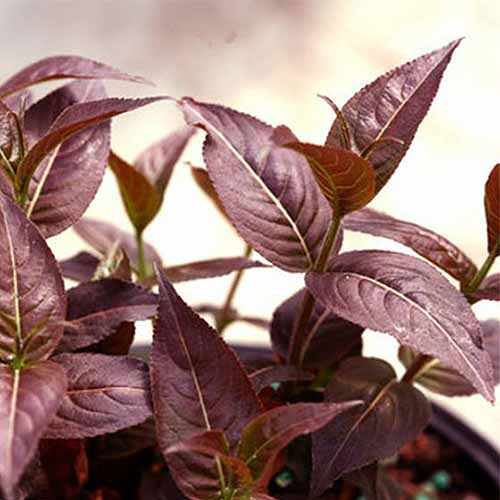
'Kodiak Ignominious'
In the past summer, shining yellow, trumpet-formed flowers emerge and last through the fall. If you're looking for a George Walker Bush honeysuckle, it's hard to disco biscuit wrong with this one.
Buy out one and only for your garden at Nature Hills Nursery.
D. Sessilifolia
The sessilifolia species is a chemical group together known as the southern bush honeysuckles.
'Cool Splash' (D. sessilifolia 'LPDC Podaras' PP19391) is a dwarf southern bush that stays below four feet tall and wide, with a mounding growth habit.
IT isn't encroaching but it is still hardy, grows highly fast, and can handle a range of conditions.
By the way, that "PP" followed by a bundle of numbers is what's known as a plant patent ID.
These patents are granted to an individual or group who excogitate a new plant direct asexual facts of life. That means they have the rights to the plant life for 20 years. But I digress…
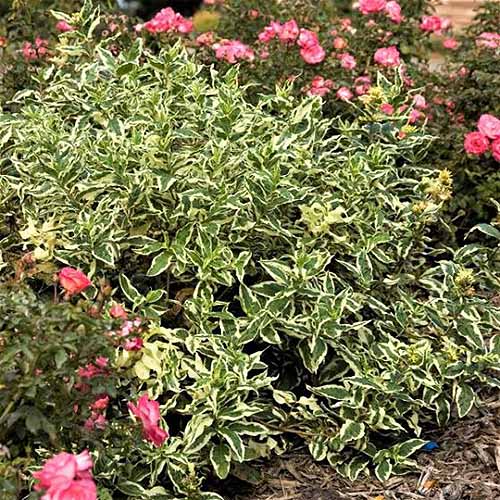
'Cool Splattering'
When it isn't covered in sweet-scented yellow flowers, the variegated green and cream foliage adds color to the garden. It grows in Zones 4 to 7 in slanted spectre to entire sunshine.
Nature Hills Glasshouse carries this bear-out bush in #3 containers.
L. Flava
Yellow honeysuckle (L. flava) has extremely fragrant sweet-smelling flowers that are, unsurprisingly, yellow, though they can have a hint of orange.

L. flava 'Yellow' is a vining plant that reaches up to 20 feet grandiloquent and six feet wide, and is manlike in Zones 5 to 8.
L. Periclymenum
The periclymenum species was imported from Europe, and thank goodness it isn't fast-growing. It's also called common Australian honeysuckle or woodbine.
L. periclymenum 'Fragrant Mist' is, as its bring up would suggest, highly scented.
Also referred to by the name 'Chojnow' PBR, denoting a cultivar registered with Plant Breeders' Rights to be sold under a encrypt name or with alternate name calling of a different language, this variety has white and Battle of Magenta flowers.

'Fragrant Cloud'
'Fragrant Cloud' is hardy in Zones 5 to 9, and reaches upwards to 10 feet tall and eight feet blanket. It's a vining case that can cover partial sun operating theater full sun.
Home Terminus carries this not-invasive dish.
L. Sempervirens
Coral, trumpet, surgery scarlet honeysuckle (L. sempervirens) is an excellent choice if you want a non-invasive option to replace Japanese honeysuckle.
It's vigorous, pest and disease insubordinate, flowers profusely, and is extremely low-set maintenance.
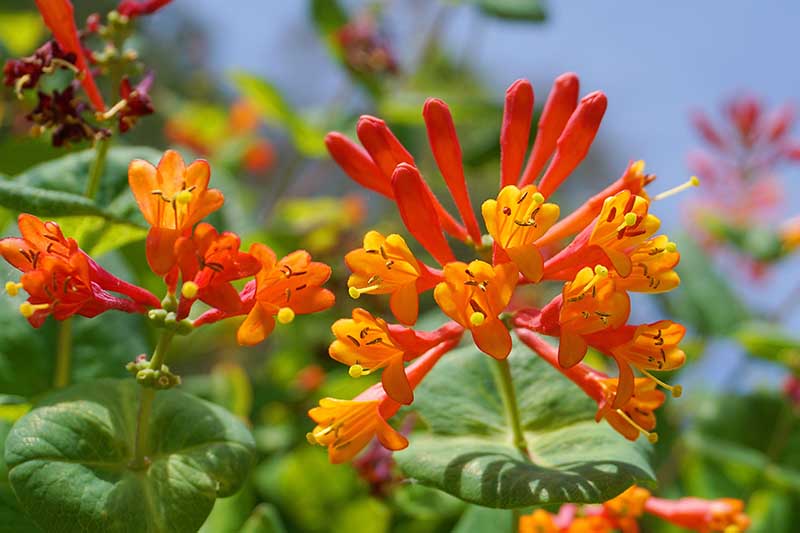
The large flowers are red or burgundy on the outside, and aureate, chicken, or orange in the gist, though in that respect are a few cultivars with different blossom colors.
It can grow up in a wide swan of Zones from 4 to 9, and even in Zone 3 with some winter protection. It grows to 20 feet unbelievable with support, and six feet wide-cut.
This species grows incredibly chop-chop without being invasive, which is probably why it's one of the most popular Second Earl of Guilford American honeysuckles out at that place.
There are a fewer exceptional chromatic cultivars worth observation for:
'True cedar Lane' has two-inch-long flowers that are vermillion on the exterior and yellow on the interior. 'A Cherry-red' features crimson red flowers with lightless fleeceable-blue leaves. 'Privy Clayton' has bright yellowness flowers, and it tends to rebloom a second gear time per year.
'Starring Wheeler' is such a prolific bloomer that you can't tell it even has leaf when it's blooming. The twinkling red and orange tubular flowers emerge in late spring and stick until autumn.
IT grows quickly and is partially evergreen in Zones 6 to 8, though it can arise in gardens down to Zone 4. And information technology spreads about 10 feet astray and eight feet tall.
Hybrids
L. x brownii 'Dropmore Scarlet' is a vining character that is vigorous without being invading. It has intensely scented two-inch-long blossoms in pink and orange.
This is a hybrid cross between L. sempervirens with L. hirsuta. It doesn't draw too large, staying rightfulness around five feet tall and wide, and is Thomas Hardy in Zones 4 to 8.

'Dropmore Orange red'
Is she calling your name? Plunk this sweet lady up at Nature Hills Baby's room in #3 containers.
Gorgeous 'Goldflame' (Genus Lonicera × heckrottii) is a vining type with stand-out flowers that feature article bright orangish-yellow interiors and medium empurpled-knoc exteriors.
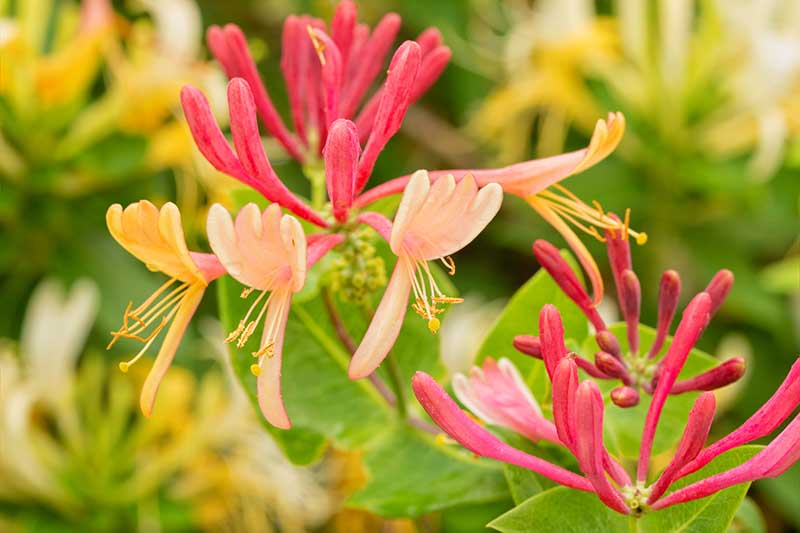
It was created by crossing L. americana and L. sempervirens , and is manful in Zones 4 to 9. In the right conditions, it quickly grows to 15 feet.
Managing Pests and Disease
Nonpareil of my favorite things about growing honeysuckle is that it is wonderfully untroubled by pests and diseases.
I've ne'er had to deal with either in my garden, though I know a few people who have seen aphids and fine mildew on their plants.
Herbivores, connected the other hand… Lashkar-e-Toiba's just say the deer seem to think honeysuckle is the equivalent of their own personal glaze shop.
Herbivores
More than pests and diseases, herbivores have the potential to cause problems because they can't resist the tender puppyish leaves and flowers of Australian honeysuckle.
Cervid
IT's nobelium marvel deer equal honeysuckle. If you've ever popped the flowers out and sucked the sweet juice from the base, you know that they'Ra tasty.
If you have deer in your area, you'll need to deter them or you endangerment losing your plants. We have a helpful guide with scads of different options to deter deer.
Rabbits
Excited bunnies eff youngish honeysuckle leaves and flowers. They won't rag the woodier parts of the plant, sol your vine or bush is usually safe once information technology grows a bit senior.
To protect your young plants, barriers are your unsurpassed option. Our article on deterring rabbits can service.
Insects
One of the reasons honeysuckles are so popular is because they're generally untroubled by insect pests. There's only ace type that you will unremarkably come across.
Aphids
Perhaps IT would be easier to list the plants aphids don't like to attack than the ones they do.
Honeysuckle is yet another plant that aphids – Hyadaphis foeniculi particularly, in this case – just can't stay away from. And they'Ra the most problematic pestilence you'll encounter when growing honeysuckle.
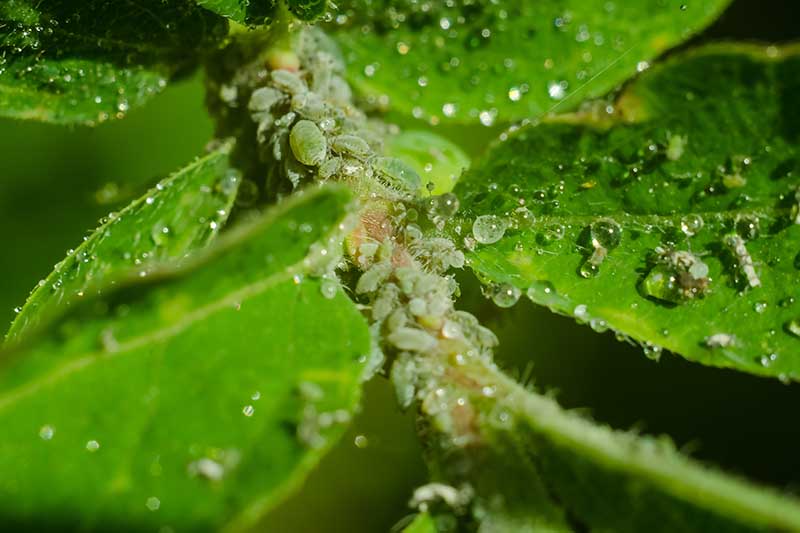
The good news is that controlling and getting disembarrass of them isn't too unruly. Unless you calve plants and a seriously large infestation, aphids don't effort too some damage.
Chances are you'll come across the fly honeysuckle aphid or coriander aphid, as it is commonly known, as substantially atomic number 3 other types of aphids, in your garden at both point.
Give our guide to controlling these common pests a read to see how to prevent, spot, and stop them.
Disease
But every bit you father't often see pests on honeysuckle, you'll rarely encounter diseases either.
Fine mildew is more inferior, only you'll sometimes see leaf plague, also. Neither leave typically kill your plant unless it is small or weak.
Leaf Blight
Leaf plague is caused by the fungus Insolibasidium deformans. If this fungus is present, new leaves in the spring will show light yellow or tan patches at first. Those spots eventually darken and become necrotic over the growing season.
The underside of affected leaves volition have a silver, pulverised application, which is the fungus. The leaves bequeath eventually curl and descend from the plant.
Prevention is best, and you can manage that by retention the plants pruned and well-double-spaced, and watering at the soil horizontal surface rather than on the leaf. Clean up fallen leaves in the fall, since the fungus kingdom overwinters on plant material.
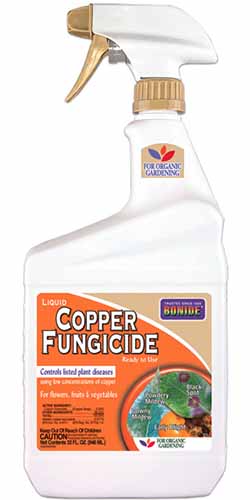
Bonide Copper Antimycotic
If it's too belated for bar, you'll need to pause out the antifungals. Copper sprays are effective against this disease.
I like Bonide's Liquid Copper, which is available at Arbico Organics in 16- or 32-ounce ready-to-use containers, or a 16-Panthera uncia concentrate.
Nebulizer plants every 10 days or so for as long as symptoms are present. Be for sure to spray the undersides of the leaves.
Light-colored Mildew
Powdery mildew is another fungal disease. It's caused by the pathogen Genus Erysiphe caprifoliacearum var. flexuosa. Again, it's not extremely common, but information technology infects plants more frequently in areas with high humidity.
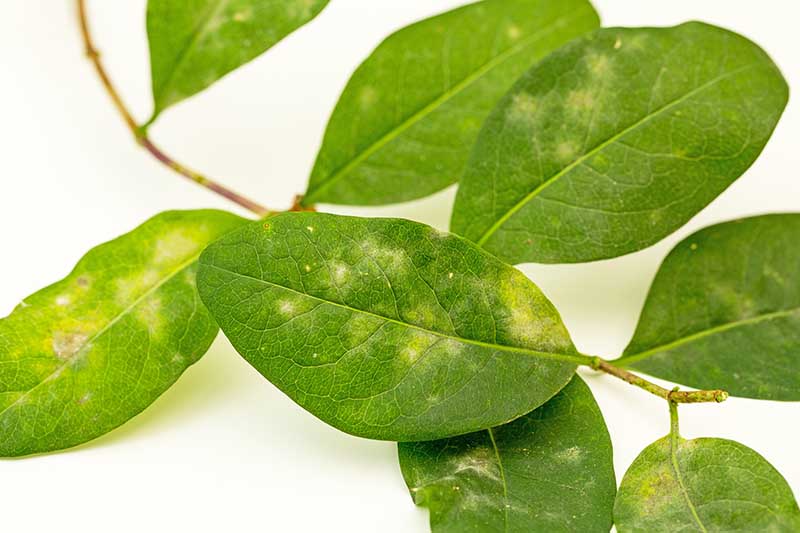
Symptoms include a powder-like finishing on leaf surfaces, branches, and buds. Leaves Crataegus oxycantha become yellow, and these will turn dry and slump the imbe.
Planting in a blot where the morning dew can air-dry off the leaves quickly, and keeping plants well-single-spaced and pruned, goes a extendable way to preventing this disease. Also be sure to remove any dead plant textile from the ground in the come.
If your plants exercise final stage up with light-colored mildew, try an antifungal agent such atomic number 3 a copper fungicide as described above, or a sulfur fungicide.
Treat all 14 years until symptoms are single-minded.
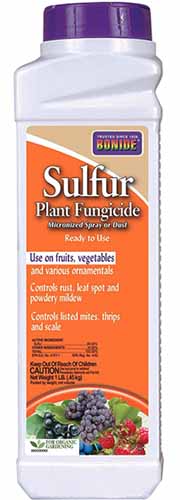
Bonide Sulfur Antifungal
Arbico Organics carries one- and 4-pound bottles of Bonide Atomic number 16 treatment.
Early handling is first. Once this fungus has gotten its hooks into your honeysuckle, it's hard to eliminate.
If treatment International Relations and Security Network't helping, stop treating and let the plant go hibernating in the fall. Then, in the spring every bit the leaves emerge, start spraying again even if you can't control whatsoever symptoms. It's a good deal easier to prevent the disease from taking hold than it is to get rid of it.
Learn more well-nig how to treat pulverized mildew in our guide.
Best Uses
Both bush and vine types are lovely in cottage gardens, and they add an intense fragrance to the air throughout the summer.
Bushes serve fortunate as hedges operating theater they put up atomic number 4 used to offer height in a garden. Vining types are faultless to cover fences, trail down rock walls, or plow trellises and arbors.
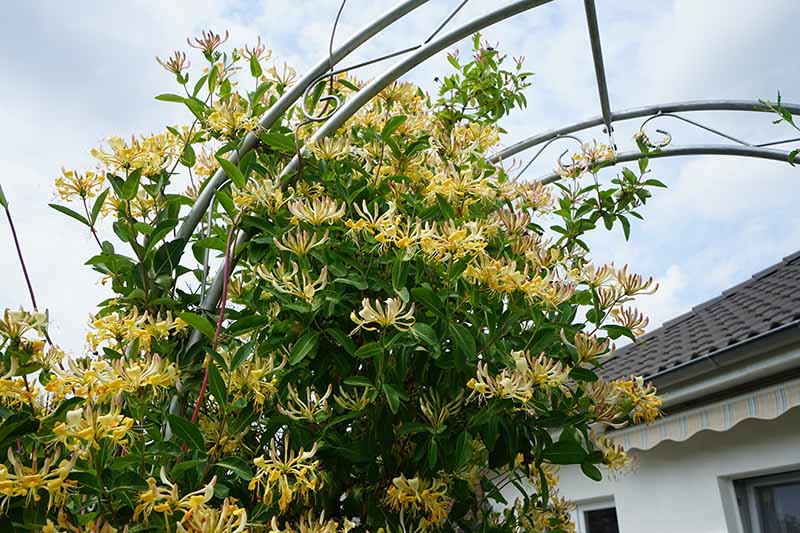
Plant anyplace you want to enjoy the fragrance, such Eastern Samoa next to Windows or patios. Just remember that the blossoms as wel attract bees.
To produce a hummingbird garden, plant with firecracker plant, columbine, forest pinkroot, bee balm, foxgloves, butterfly bush, Beaver State sage.
Of course, lots of kids (and adults like myself) like to pinch the flowers and take out the stamen, which has few drops of sweet ambrosia on that.
Just be sure that if you run through from a plant that you don't know, gibe to see if it has been sprayed with chemicals prototypical. You should also always be certain that you have properly known your plant if you're foraging.
You privy eat the flowers of few species as easily. They're lovely in salads surgery as a topper for desserts. Try sugaring them, with these instructions from our sister site, Foodal.
Honeysuckle flower afternoon tea is exceptional. It's naturally sweet and floral tasting. But once more, use admonish.
While there are a few species that are non at all poisonous, most undergo just about plane of toxicity and can suit serious health issues in large enough doses.
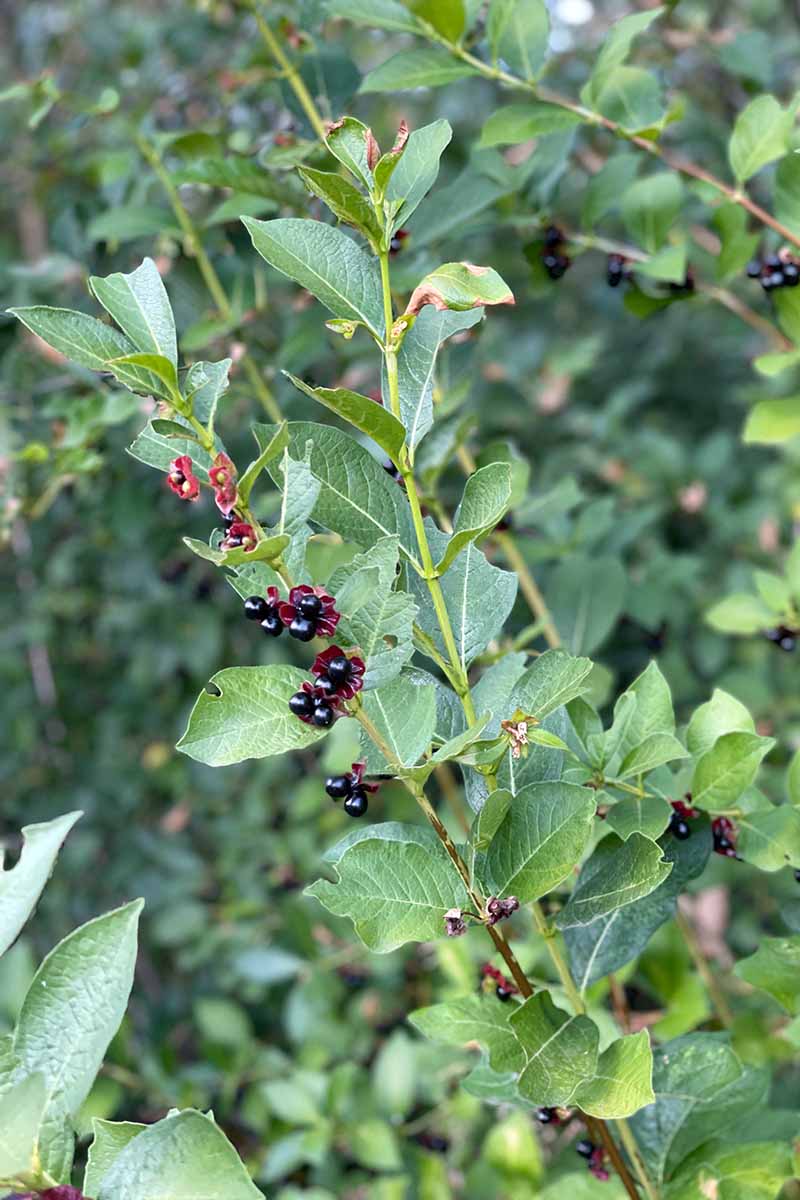
Too, be aware that most honeysuckle species have berries that are poisonous, and these can be toxic especially if you deplete them in large enough quantities.
A few have comestible berries (so much as L. involucrata and L. utahensis, which are known as twinberry honeysuckles), but it's probably smart to suss out with an expert before you start harvesting the berries.
If you can't personify sure, leave them to the birds; they'll appreciate the snack. Leaves and stems may also exist poisonous, though not always. Better safe than sad.

The berries from any species English hawthorn besides be victimized to make a unaffected dyestuff, giving hair and textiles an inky majestic chromaticity.
All parts of the plant are extremely toxic to canines and felines.
Hurried Reference Healthy Guide
| Plant Case: | Woody flowering bush or vine | Flower / Foliage Color: | Cream, white, yellow, pink, orange, red, purple, magenta/honey oil, cream |
| Native to: | Eurasia, North America | Margin: | Drouth, several shade |
| Hardiness (USDA Zone): | 3-9 | Maintenance | Low |
| Bloom Time: | Spring-summer | Soil Type: | Clay, loamy, sandlike |
| Exposure: | Full sun to part shade | Soil pH: | 5.5-8.0 |
| Time to Maturity: | 5-10 years | Soil Drainage: | Well-draining |
| Spacing: | 5-10 feet, conditional species | Attracts: | Bees, butterflies, hummingbirds |
| Planting Depth: | 1/8 inch (seeds), depth of container (transplants) | Companion Planting: | Bee balm, butterfly stroke bush, columbine, firecracker plant, foxgloves, sage, timbe pinkroot |
| Height: | 4-30 feet | Stave off Planting With: | Clematis |
| Bed cover: | 4-10 feet | Uses: | Hatful planting, hedge, wall or rockery, dyestuff, edible nectar |
| Growth Rate: | Moderate to fast | Menag: | Caprifoliaceae |
| Water supply Needs: | Nether to moderate | Genus: | Lonicera, Diervilla, Leycesteria |
| Common Pests and Disease: | Deer, rabbits; aphids; flip blight, powdery mildew | Species: | Americana, arizonica, bella, caprifolium, ciliosa, fragrantissima, flava, heckrottii, henryi, hispidula, involucrata, Chaenomeles japonica,, hildebrandiana, lonicera, morrowii, periclymenum, rivularis, sempervirens, sessilifolia, tatarica |
Bring the Pleasantness of Honeysuckle to Your Home
The experience of the pungent, sweet scent of honeysuckle on the aura is something you're not expected to ever forget.
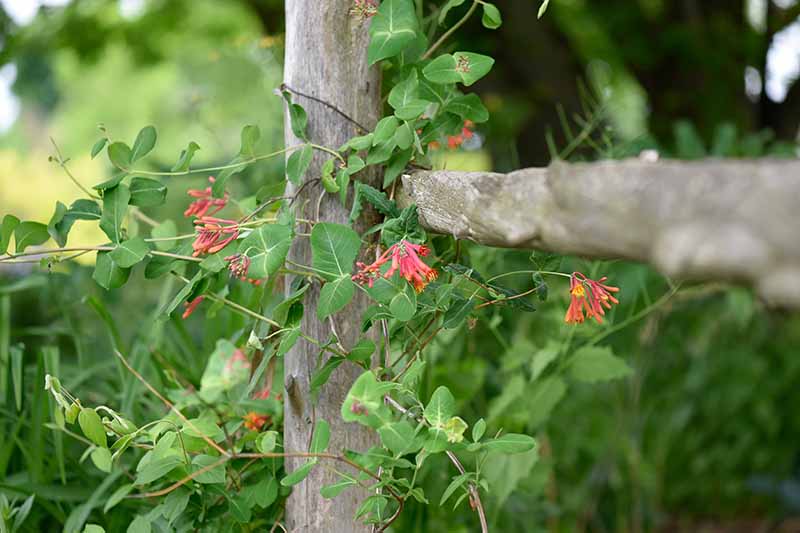
Now you'atomic number 75 fix to go out and start creating your possess honeysuckle memories, without the danger of planting something that's all wrong for your area.
Comprise certain to come back and let us know which species you end upward with and how IT's doing in your yard in the comments below.
Then, if you're looking for more help connected growing flowering vines in your garden, read these guides close:
- How to Arise and Care for Passionflower vine
- How to Spring u Carolina Jasminum officinale
- How to Grow Dolichos labla Vines
https://gardenerspath.com/plants/perennial/grow-colorful-fragrant-honeysuckle/
Source: https://gardenerspath.com/plants/perennial/grow-colorful-fragrant-honeysuckle/
0 Response to "How to Grow Honeysuckle"
Post a Comment